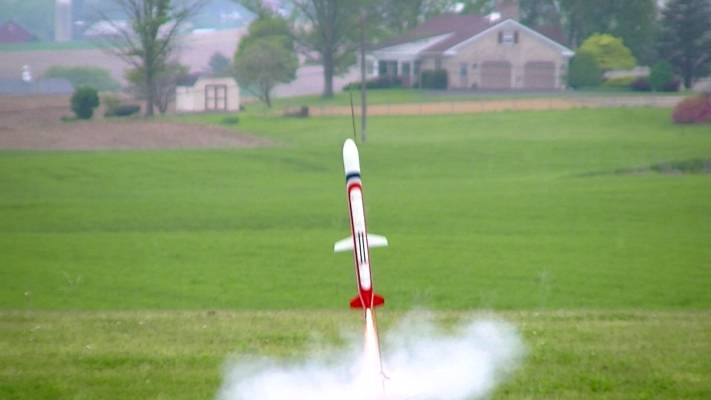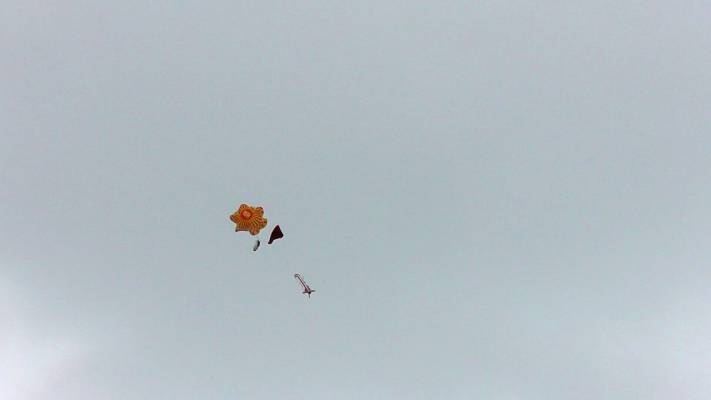The Tomahawk: This is a sport-scale model of the Surface-Launched Cruise Missile (SLCM) used by the US Navy, painted in colorful red-white-blue that was probably for marketing but not very likely used on the missiles used in service. I believe that this model is not to-scale as it appears to be a bit too long and has smaller wings and a smaller air intake so that this model will fly well as a rocket. It also doesn't usually explode at the end of its flight like the real thing (one would hope).
BUILDING:
The air-intake is made from a light cardboard. I considered re-making this out of a thin balsa wood, but figured it was unlikely to get damaged during flight because of its location. As it happened, I pressed a little too gingerly on the rocket while applying decals, and bent it a bit. It returned to shape, but not before it cracked the white gloss finish on it. The cracks are not very noticeable on the photo. If you build this model, I suggest soaking the folds of the cardboard with CA glue to harden them. Mine started to split while handling the rocket while sanding the finish.
You may notice I tapered the launch lugs on this model; partly for cosmetic reasons, and partly because it might reduce air drag, but I don't know that it's been scientifically proven. The air-intake adds drag I'm sure, but I am banking on it not being that much of a problem, so I didn't go through with my thoughts of providing vent holes on the back of the scoop, which would make the model look a bit odd and would not entirely reduce the drag anyway. We'll just have to see if this model can hit the 600 foot apogee as claimed by Quest.
FINISHING:
The color difference in the blue Testors paint and the decal's blue shade doesn't look too bad in this photo, but in person you will be able to see the shade difference easily. Take a close look behind the air-intake where the square panel decal is. Behind that there was a gap in the blue decal which I covered with the blue from a second set of Quest decals. Even in this photo, you can see the obvious shade difference between the two blues of the decal sheets from Quest. The purple-ish square is from a set of Quest decals I didn't use. If you build this kit, I wish you the best of luck getting the paint and decal shades to match, but don't count on it.
Quest's instructions do not tell you where to place all the decals. You have to get a little creative. Also, the geometry of the rocket and decals does not match, so you will have to be careful and flexible when applying them. The locations of the decals and the air-intake, wings and other features do not line up as shown in the illustrations (which don't exactly match themselves!). I used Testors spray paints. The red came out as a very close shade to the decal shade, but the blue was pretty far off the mark. I had a second set of decals from Quest, and the blue on the decals looked quite a bit different than the blue decals I used on this rocket. I think color matching the decals and the paint will probably be something of a crap-shoot.
Sadly, I also applied a clear-coat on top of the decals to protect them. This was also Testors brand, the same as all the paint. Perhaps I sprayed it on too thick, but even though the decals had several days to dry, the clear-coat seemed to soak in to the decals and wrinkle them all up (after the photographs at least). So while this model looks good from a distance at launch, up close it's more like a wrinkled old man.
FLIGHT TESTS:
As expected, this model didn't perform close to Quest's prediction. In light winds with a C6-3, it reached 492 feet, on a B6-4 it only reached 132 feet. Flights were made with an Altimeter 2 inside clipped to the nosecone. In spite of the altitudes, the flights went very well and were quite satisfying; I expect to be flying this model a lot. This rocket has flown higher than the Great Pyramid of Giza in Egypt, even before it lost about 26 feet from erosion. It could have flown over the Kingda Ka Roller Coaster in Jackson.
| Flight Date: | 2012-05-06 |
| Rocket Name: | Tomahawk SLCM |
| Kit Name: | Quest - Tomahawk {Kit} (3007) [1994-] |
| Flyer's Name: | Rich DeAngelis |
| Motors: | B6-4 |
| Expected Altitude: | 130 Feet |
| Wind Speed: | 3.00 mph |
| Launch Site: | Penn Manor School Lancaster PA |
| Actual Altitude: | 144 Feet |
Last flight of the day. I was being pressured into making a quick last flight because the club wanted to pack up for the day. I abandoned my plans to launch a more complex composite-motor flight or a 2-stage flight, and instead opted for a simple flight with a reliable rocket that has historically flown well in any conditions: The Quest Tomahawk. It flies in any winds and does not travel too far up. The wide body makes packing a parachute easy, and with a Nomex sheet inside it doesn't even need wadding.
After ignition the rocket accelerated at 13.5 Gs, averaging 3.3Gs for the 0.8 second burn. It was traveling at 60 mph and coasted for 2.7 seconds to an apogee of 144 feet in a wide arc. 1.1 seconds after apogee, having descended 25 feet, ejection fired and the parachute opened cleanly. It settled to the ground at 8 mph to within 100 feet of the launch pad. The flight was over after 20.2 seconds. Perfect success.
More importantly, I ended the day's flying with 6/6 opened parachutes, compared to last month's flying where I had six parachute failures! (The 2-stage wreck had a streamer - ha!)
| Stage | Motor(s) |
|---|---|
| 1 | B6-4 |
 |
 |


